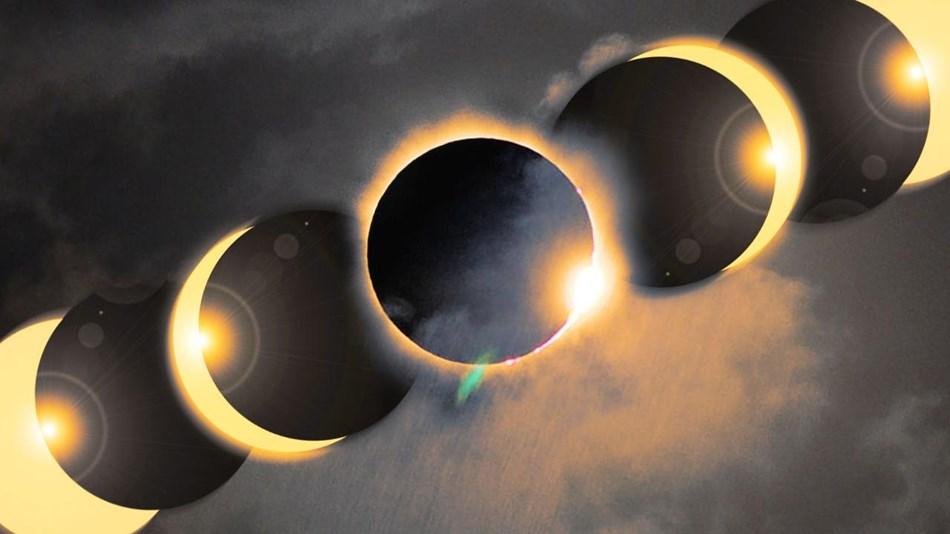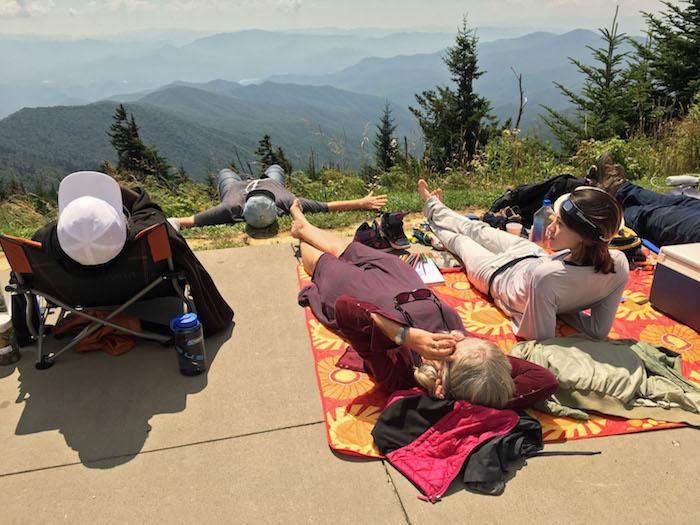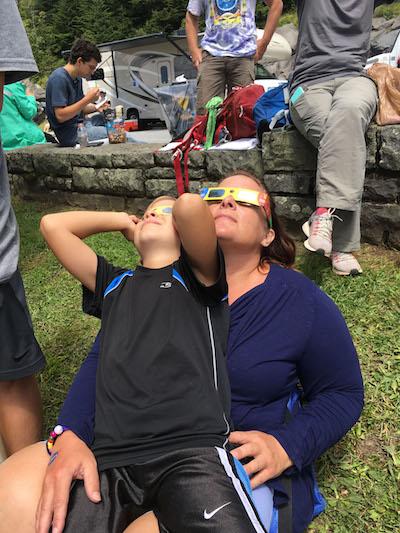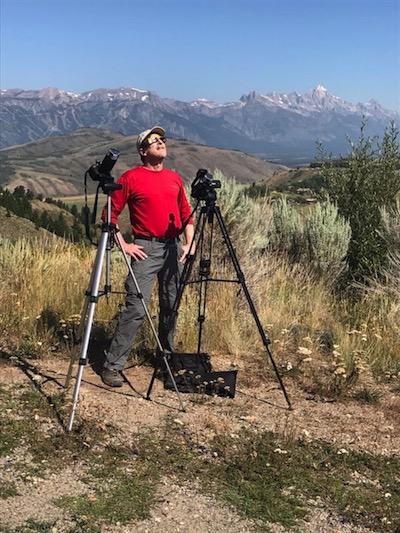Eclipsing The National Parks

The Great Eclipse Party on Clingmans Dome in Great Smoky Mountains National Park
By Danny Bernstein
The National Park Service knows how to a great party.
“We’ve been working on this eclipse event for over 13 months,” said Cassius Cash, superintendent of Great Smoky Mountains National Park, while standing at Clingmans Dome, on the border of North Carolina and Tennessee.
"Cash," as the superintendent is known, was shaking hands and getting his picture taken with whomever asked. At 6,643 feet on the roof of the park, the weather Monday was mild, dry, and mostly sunny – perfect. You could see a partial eclipse anywhere in the United States, but on Clingmans Dome, it was going to be a total eclipse.
Eclipse Day – Monday, August 21- was supposed to have been a traffic and crowd nightmare, according to the media in western North Carolina. People were going to pour into the Smokies, Asheville, North Carolina, and Greenville, South Carolina, clogging the roads.
The park had created a brilliant plan. They sent out this invitation on their website:
The National Park Service in collaboration with NASA, the National Institute of Aerospace, and Southwest Community College is hosting a staged event to celebrate the 2017 total solar eclipse as it passes over Clingmans Dome in the Great Smoky Mountains National Park. The 4-hour broadcast will explain the science and physics of the eclipse, offer musical sounds of Southern Appalachia, and help viewers create their own stories about this once in a lifetime experience. Join NASA 360 on August 21 as we witness the ecliptic shadow across this majestic landscape from one of the highest points on the east coast.
In reality, by the time anyone had read this, all the tickets to the Clingmans Dome event were gone.
On March 1 at 9:55 a.m., I sat ready at my computer with a credit card in one hand and my Recreation.gov password in the other to get four tickets to watch the eclipse at Clingmans Dome. At ten o’clock, the tickets became available for $30 each. Somehow, I was one of the lucky ones. As rumor has it, five minutes later, the park sold out its 1,600 tickets. I invited three lucky friends. One cancelled the day before because of work but by then, everyone else I knew had eclipse plans.

Waiting on Clingmans Dome for the eclipse/Danny Bernstein
The email confirmation from Recreation.gov came with two pages of instructions. The most important warning was that ticket holders could only get to Clingmans Dome via shuttle buses from Gatlinburg, Tennessee, and Cherokee, North Carolina. Somehow, I was assigned to a spot in Gatlinburg.
Without tickets, you could head to other more informal and free places to see the eclipse – Cades Cove and Oconaluftee Visitor Center - and much of the rest of the park. Only Clingmans Dome Road was closed to the public on Sunday and Monday.
Eclipse viewing glasses disappeared from stores in Asheville a couple of months before the event. Thank goodness that the park gave out the sunglasses. Proper eye protection was necessary when you looked at the sun, except for totality, or else you’d fry your eyes. On Clingmans Dome, totality lasted less than a minute and twenty seconds.
I had left home on Sunday and spent the day in the park so to be as close as possible to Gatlinburg on Monday morning, but the bumper to bumper traffic didn’t materialize.

Eclipse gazing atop Clingmans Dome/Danny Bernstein
So much excitement on the bus. It felt like a fifth-grade school trip. A volunteer, assigned to each bus, gave us a safety lecture, mostly on how to use the glasses.
“Put your glasses on at one o’clock, when the partial eclipse starts. Turn away from the sun and put your glasses on. Then turn around to see the sun. When you want to take them off, turn away from the sun first.”
When we finally arrived at Clingmans Dome, many had staked out their positions, facing west, but there were plenty of good viewing spots. Some sun gazers brought folding or blow-up chairs. For others, blankets or towels sufficed. One couple had put up a hammock between two trees on the far side of the mountain.
A large stage had been erected where pre-show performers played music. Emily Calandrelli, the host and producer of the TV show, Xploration Outer Space, was the emcee. The sentiment seemed to be keep the visitors entertained and busy. A long line had formed to meet Soichi Noguchi, an astronaut and former president of the Association of Space Explorers, and get his autograph.
After Superintendent Cash welcomed visitors, we heard from Richard Sneed, Principal Chief of the Eastern band of Cherokee Indians, the Indian reservation that borders the North Carolina side of the park. He related how the Cherokee people pictured the eclipse as a frog eating the sun. The story has been used on the reservation to explain eclipses to children for generations.
National park rangers and a ton of volunteers had little to do but smile and greet people. No emergency, no scuffle, no misunderstanding among 1,600 people – just a good feeling. Meanwhile, the media roamed the Dome and talked to visitors and invited guests. Telescopes had been set up at just the right angle. We didn’t need glasses while looking through the telescopes.
Some people had stretched out on the ground wearing their eclipse glasses and watched as the moon covered more and more of the sun. I put on my glasses on and off but got restless so I walked the half-mile up to the Dome. The tower, itself, was reserved for the press. WRAL, the Raleigh, North Carolina, television station, had parked their truck on top. Some reporters were driven up by golf carts.
When I got to the top as far as visitors could go, I saw two backpackers come out of the woods and off the Appalachian Trail. Paul and Alli from Michigan had camped at the Mt. Collins shelter, about three miles north of Clingmans Dome and popped out to participate in the excitement. They didn’t have glasses but they waited for totality, like everyone else.
I walked back down with them because I wanted to be part of the group when the moon covered the sun. An eclipse is such a big, rare event that I felt that it’s meant to be watched with other people.
Calandrelli, the emcee, was prepping us for the big moment. “When totality occurs, I will blow the whistle and you can take off your glasses. Ten seconds before it’s over, I’ll blow the whistle again so you can put your glasses on again.”
“Experience the eclipse,” another speaker said. “Don’t try to take pictures. NASA does it better. So, put the phone down”.
Finally, the host blew the whistle. "Ooh" and "aahs" from the crowd as we took off our glasses. We clapped at the sun, the moon, the eerie darkness.
I had read a National Parks Traveler article about listening during the eclipse, but all we could hear were the crowds around us. It felt like twilight, as if the sun had gone down, but it was certainly not fully dark. The blue and pink clouds over the horizon covered the sky like an impressionist painting. So much to look at in less than a minute and a half: the hidden sun, the far vistas and the public’s reactions. A bright-looking star in the dark sky was probably Venus.
I missed the second whistle, meant to signal that we should put our glasses on. The sun started to pop out from behind the moon. A bright light, referred to as a diamond ring, shone right in my eyes as the moon moved away.
I don’t think I’m supposed to look at this, I thought and turned away from the sun. One more round of applause and the total eclipse was over.
Now the crowd was no longer interested in the partial eclipse that followed. We had been on the Dome for almost four hours. People started lining up for the buses to take us back down, out of the park and to our cars. Still holding on to our glasses, we got on the bus.
The next total eclipse will be in 2024 but not anywhere near the southern Appalachians. For me, this was really an experience of a lifetime.









Comments
My wife and I viewed the eclipse from Agate Fossil Beds National Monument. The crowd and the experience made for a spectacular event. Most impressive was the yellow hue for 360 degrees at the horizon and of course the diamond ring effect at beginning and end. We had originally planned to see it at our home in Lincoln, NE, but changed our minds and drove due to a forecast of clouds for Lincoln.